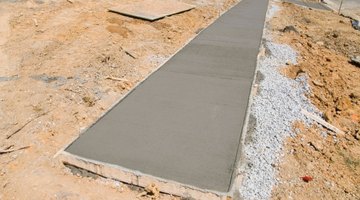How to Protect Fresh-Poured Concrete from Rain
After pouring a concrete surface, it is critical that it not get wet so it can dry and cure to full strength. If the concrete is not fully dry and rain is expected, take immediately steps to protect the concrete until the rain subsides.

Unprotected concrete can develop depressions and dimples from rain drops and if too much rain occurs, it deteriorates the composition of the concrete. Proper protection can be accomplished with standard work supplies.
Things You Will Need
- Polyethylene sheeting or burlap
- Boards or bricks
- Broom (optional)
Warning
Do not use a float or trowel on the concrete while the water is still present, which pushes the water down into the concrete and weakens the mixture.
-
Locate polyethylene sheeting or burlap and stretch it over the entire area of wet concrete extending it over the edges by at least 6 to 12 inches to prevent rain from splashing under it. Make sure that no part of the concrete is exposed.
-
Set wooden boards or bricks around the perimeter of the plastic or burlap to prevent it from blowing off if heavy winds occur along with the rain fall.
-
Wait until the rain stops and remove the covering from the concrete immediately to allow the concrete to continue drying.
-
Examine the concrete surface to see if any rainwater pooled on it despite the precautions. If rain water is present, remove it using a broom and barely touching the top of the concrete with the bristles. Allow all water to completely evaporate from the surface before proceeding with the installation process or further construction work.
The Drip Cap
- After pouring a concrete surface, it is critical that it not get wet so it can dry and cure to full strength.
- Unprotected concrete can develop depressions and dimples from rain drops and if too much rain occurs, it deteriorates the composition of the concrete.
- Allow all water to completely evaporate from the surface before proceeding with the installation process or further construction work.
References
Writer Bio
Kimberly Johnson is a freelance writer whose articles have appeared in various online publications including eHow, Suite101 and Examiner. She has a degree in journalism from the University of Georgia and began writing professionally in 2001.
Photo Credits
- Jupiterimages/Comstock/Getty Images
- Jupiterimages/Comstock/Getty Images
More Articles



